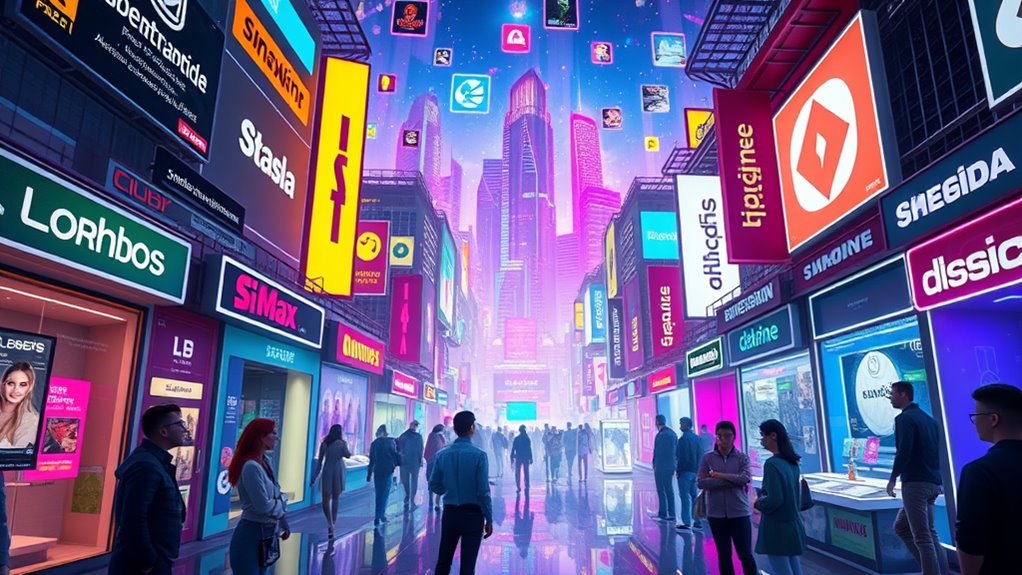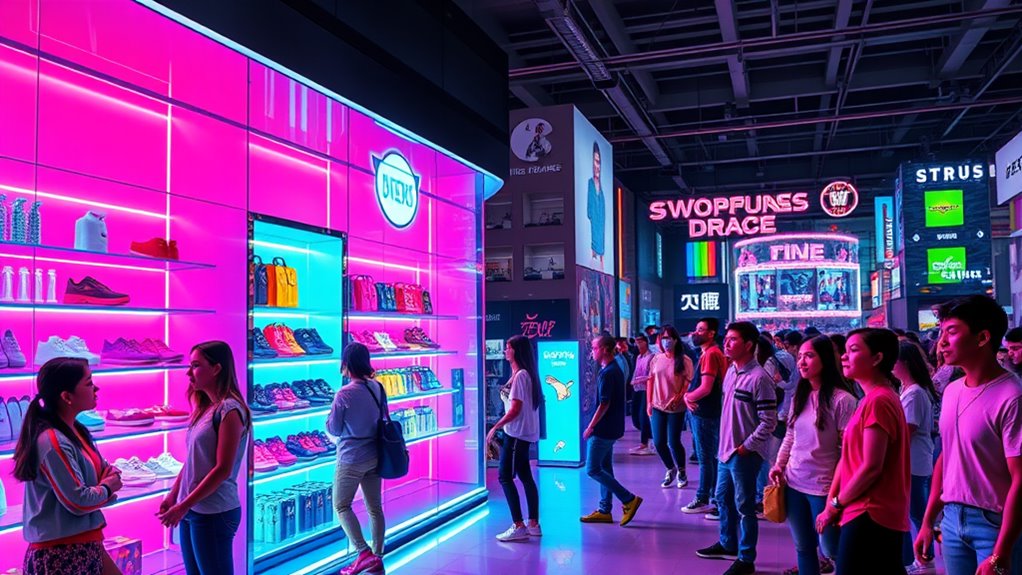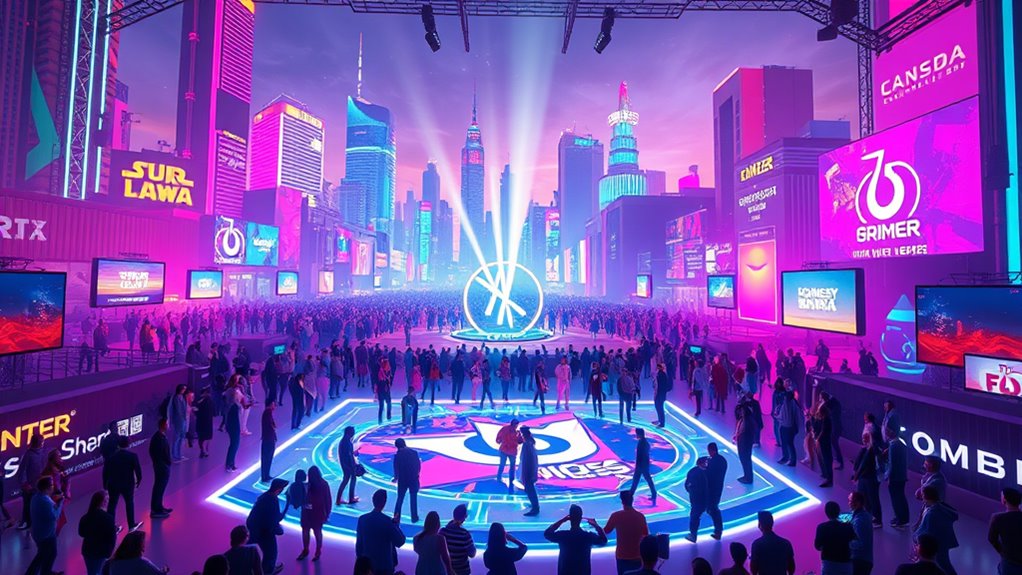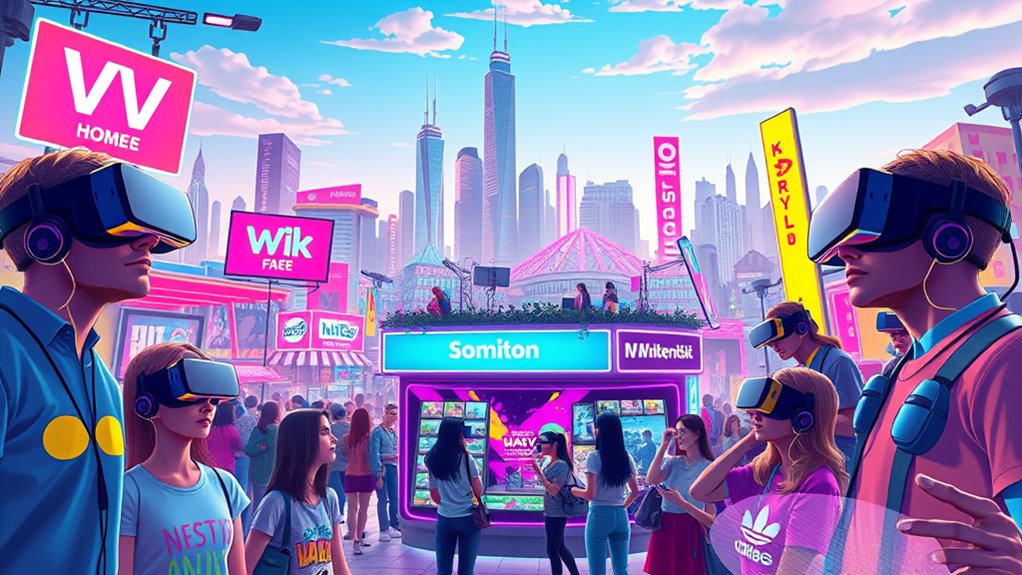
How Brands Are Entering the Metaverse: Top Strategies Revealed
Brands are entering the metaverse through various strategies. Virtual stores utilize VR and AR for immersive shopping experiences. Interactive gaming allows brands to engage consumers meaningfully. Hosting virtual events enhances brand engagement through real-time interactions. Additionally, NFTs and digital collectibles create unique consumer experiences and redefine ownership. These approaches help brands expand their market reach and generate new revenue streams. Understanding these strategies provides deeper insights into how brands connect with consumers in the metaverse.
Key Takeaways
- Brands create immersive virtual stores utilizing VR, AR, and AI for enhanced consumer shopping experiences without geographical limitations.
- Engaging through interactive gaming experiences allows brands to connect with younger audiences and foster community loyalty through play-to-earn models.
- Innovative brand integration strategies, such as virtual events and themed environments, enhance visibility and engagement in the metaverse.
- Hosting virtual events with storytelling and gamification promotes brand interaction while generating revenue through ticket sales and subscriptions.
- Leveraging NFTs and digital collectibles enables brands to redefine ownership and expand market reach within the metaverse.
Virtual Stores and E-commerce Innovations

As brands increasingly explore the metaverse, virtual stores have emerged as a significant innovation in e-commerce.
These digital environments utilize advanced technologies such as virtual reality (VR), augmented reality (AR), and artificial intelligence (AI) to create immersive shopping experiences. Customers can interact with 3D product catalogs, enabling them to view detailed representations and even virtually try on items.
This innovation expands global accessibility, allowing brands to reach consumers without geographical limitations. Additionally, blockchain technology facilitates secure transactions, enhancing trust in digital purchases.
Engaging Through Interactive Gaming Experiences

Engaging through interactive gaming experiences allows brands to connect with consumers in innovative ways. By employing immersive gameplay mechanics and strategic brand integration, companies can create memorable experiences that resonate with users. Collaborative game experiences further enhance these interactions, fostering a sense of community among players while promoting brand loyalty. As brands explore these opportunities, they can leverage cryptocurrencies for secure transactions to facilitate in-game purchases and enhance user engagement.
Immersive Gameplay Mechanics
Immersive gameplay mechanics play an essential role in the metaverse, particularly in fostering deeper player engagement. These mechanics often feature interactive elements that enhance connections between players and virtual environments.
Advanced graphics engines are employed to create visually appealing games, making experiences more enthralling. Some games utilize play-to-earn models, offering economic incentives through NFTs or in-game tokens, which add a layer of motivation for players.
Multiplayer experiences also contribute greatly, encouraging social interactions among users. Additionally, engaging storylines are vital; companies like Cryptic Studios craft rich narratives that keep players invested.
Brand Integration Strategies
Brands are increasingly finding innovative ways to integrate themselves into the metaverse, utilizing interactive gaming experiences to enhance their visibility and engagement. By creating immersive environments, brands can connect with consumers in unique ways. For example, Nike’s Nikeland on Roblox allows users to play sports games while collecting branded items. Similarly, Gucci has developed a virtual garden in Roblox for shopping experiences. These strategies highlight the importance of engaging users through interactive platforms. The table below illustrates various brand integration strategies in the metaverse:
| Strategy | Example |
|---|---|
| Virtual Events | Fortnite concerts and events |
| Themed Islands | NARS Cosmetics’ branded islands on Roblox |
| Interactive Billboards | Decentraland’s engaging advertisements |
| Personalized Digital Products | Fortnite’s customizable skins |
| Virtual Shopping Experiences | Gucci’s metaverse garden |
Collaborative Game Experiences
As brands explore new avenues in the metaverse, collaborative game experiences have emerged as a key strategy for user engagement. Companies like Nike, Gucci, and Vans utilize platforms such as Roblox to create immersive environments where users interact with brand products.
These experiences often include games, concerts, or challenges that promote brand themes and foster emotional connections. Unlike traditional advertising, interactive gaming leads to higher engagement rates, particularly among younger audiences.
Hosting Virtual Events for Brand Engagement

How can virtual events in the digital domain enhance brand engagement?
Virtual events provide immersive experiences that utilize virtual reality (VR) and augmented reality (AR) technologies to captivate audiences. Platforms like Meadow facilitate large-scale gatherings where participants can engage as avatars, fostering a sense of presence.
These events enable brands to connect with thousands globally, overcoming geographical limitations. By hosting product launches or corporate announcements, brands encourage real-time interaction, enhancing user engagement.
The integration of storytelling and gamification creates compelling narratives that guide attendees through the brand experience. Additionally, data analytics allow brands to gather insights for refining future events, ensuring continuous improvement in audience engagement strategies.
This innovative approach greatly elevates brand visibility and community interaction in the digital domain.
Leveraging NFTs and Digital Collectibles

NFTs and digital collectibles have emerged as transformative tools within the metaverse, allowing companies to redefine ownership and engagement with consumers.
Luxury brands like Gucci and Louis Vuitton are pioneering this trend, offering exclusive digital assets through innovative collections. For instance, Gucci’s SUPERGUCCI features limited edition NFTs co-created with digital artists, while Louis Vuitton integrates NFTs into its mobile game, enhancing user experience.
Adidas has also made strides with its “Into the Metaverse” collection, offering unique digital items. Brands like Nike and Burberry leverage NFTs to create interactive experiences, including virtual sneaker design and collectible toys.
Enhancing Consumer Interaction and Community Building

In the evolving landscape of the metaverse, brands are focusing on enhancing consumer interaction and building communities to foster stronger connections with their audiences.
They are creating personalized shopping experiences that allow consumers to engage with products through virtual trials. Gamification strategies, such as rewards for participation, encourage consumer interaction.
Brands utilize immersive storytelling to deepen connections and host real-time virtual events, enhancing consumer engagement through live Q&A sessions. Additionally, community forums and social hubs facilitate connections among users with shared interests.
Immersive storytelling and real-time virtual events foster deeper connections and vibrant community interactions among users.
Inclusive experiences and virtual meetups promote a sense of belonging. By encouraging user-generated content and establishing collaborative spaces, brands build trust and loyalty, ultimately enriching the metaverse experience for consumers.
Transforming Data Strategies for Better Insights

The metaverse presents a unique opportunity for brands to not only enhance consumer interaction and community building but also to transform their data strategies for better insights.
By collecting user behavior and interaction data, brands can make informed strategic decisions while ensuring ethical practices that respect user privacy.
Implementing blockchain and Web3 technologies fosters transparent data management, addressing security risks effectively.
Advanced analytics track user engagement, helping brands evaluate marketing campaign success and optimize content placement.
Additionally, leveraging AI and immersive technologies can enhance user experiences and personalize interactions.
Aligning data insights with broader business goals allows brands to adapt strategies based on evolving user preferences, ultimately fostering continuous innovation and iteration in their approach to data management.
Expanding Market Reach and Revenue Opportunities

As brands seek to expand their market reach in the metaverse, targeting younger demographics becomes a key strategy, especially on platforms like Roblox.
Virtual real estate investment offers brands new opportunities to establish a presence, while innovative revenue streams, such as virtual goods and NFTs, enhance profitability.
This approach not only increases brand visibility but also fosters deeper connections with a tech-savvy audience.
Targeting Younger Demographics
Targeting younger demographics presents a significant opportunity for brands seeking to expand their market reach and revenue. With a majority of Roblox users under 16, brands can engage effectively with this audience.
The oldest members of Gen Z are now earning income, making them a valuable target for marketing within the metaverse. This generation is also more familiar with virtual worlds, enhancing their receptiveness to immersive brand experiences.
Gaming remains a key attraction for younger audiences, influencing brand engagement strategies. Brands like Gucci and Nike have successfully created unique marketing opportunities through immersive experiences and digital collectibles.
As brands authentically engage with metaverse communities, they can develop meaningful connections, fostering brand loyalty among younger consumers.
Virtual Real Estate Investment
Virtual real estate investment offers a unique avenue for brands looking to expand their market reach and revenue opportunities within the metaverse. This expanding market is shaped by various factors that enhance its appeal.
- Diverse Investment Opportunities: Brands can invest in virtual land, properties, and businesses.
- Ownership and Scarcity: Ownership is secured through unique NFTs, driving demand.
- Market Growth: The metaverse real estate market was valued at $1.14 billion in 2022, with projections suggesting significant expansion by 2030.
- Technological Integration: Blockchain and virtual currencies facilitate secure transactions.
- Valuation Factors: Proximity to popular events and virtual foot traffic influence property values.
These elements present brands with innovative pathways to engage customers and generate revenue in the virtual domain.
Innovative Revenue Streams
The metaverse presents numerous innovative revenue streams for brands aiming to expand their market reach and explore new opportunities. Through various digital platforms, brands can engage customers and generate income in unique ways. Below are some notable revenue models:
| Revenue Stream | Description |
|---|---|
| Digital Goods Sales | Sale of virtual items, like avatar clothing and accessories. |
| NFTs and Art | Trading unique digital art and collectibles, enhancing brand visibility. |
| Virtual Entertainment | Hosting events and concerts, generating revenue via ticket sales. |
| Subscription Services | Offering exclusive content or experiences through membership fees. |
These strategies not only boost brand awareness but also create immersive experiences that resonate with consumers in a rapidly evolving digital landscape.
Frequently Asked Questions
How Can Brands Ensure Security in the Metaverse?
Brands can guarantee security in the metaverse by implementing robust data protocols, educating users on digital asset management, employing advanced encryption, and developing incident response plans, all while adhering to regulatory compliance and industry best practices.
What Are the Ethical Considerations for Data Collection?
The ethical considerations for data collection in the metaverse include privacy invasions, biometric risks, user consent challenges, and the need for thorough regulations. Addressing these issues is essential for protecting users and ensuring ethical practices.
How Do Brands Measure Success in the Metaverse?
Brands measure success in the metaverse through various metrics, including engagement rates, customer satisfaction, unique interactions, and sales conversions. They adapt these metrics to specific platforms, ensuring they align with evolving digital landscapes and consumer expectations.
What Technology Is Needed for Metaverse Engagement?
In a world craving connection yet isolated by screens, technology for metaverse engagement encompasses VR, AR, AI, and blockchain. These elements create immersive experiences, intertwining digital and physical domains, fostering interaction and community among users.
How Can Small Businesses Enter the Metaverse Effectively?
Small businesses can effectively enter the metaverse by conducting market research, leveraging immersive technologies, personalizing user experiences, hosting virtual events, and exploring new revenue streams, all while tailoring strategies to their target audience’s preferences.
Conclusion
In summary, brands maneuvering through the metaverse are adopting a range of innovative strategies, akin to explorers charting unknown territories. Through virtual stores, interactive gaming, and community engagement, they are redefining consumer interaction. By leveraging NFTs and hosting virtual events, companies can enhance brand loyalty and create new revenue streams. As this digital landscape evolves, brands that adapt their data strategies will gain essential insights, ensuring they remain relevant in a rapidly changing marketplace.












